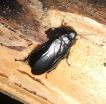(Press-News.org) PITTSBURGH--University of Pittsburgh researchers have shared their findings from three studies related to shale gas in a recent special issue of the journal Energy Technology, edited by Götz Veser, the Nickolas A. DeCecco Professor of Chemical and Petroleum Engineering in Pitt's Swanson School of Engineering.
In the special issue focusing on shale gas, Pitt faculty authors look at "smart wells" that use wireless communication, wastewater management, and information gaps between legislators, regulators, industry representatives, researchers, and the public on the health and environmental impacts of shale gas drilling. The issue also includes contributions from experts from across the United States, Europe, and Asia.
Veser, who is on the journal's editorial board, says, "I saw an opportunity to create visibility for the journal by issuing a special issue on this topic, which has garnered much attention worldwide, and at the same time highlight some of the world-class expertise in this area on our campus as well."
Pitt faculty members contributed three papers to the issue.
Smart Wells
Andrew Bunger and his co-authors propose the development of a series of sensors sunk into wells that will allow drilling companies to pull data from the deep and use that information to optimize sections of productive wells, ramp up or shut down unproductive sections, and find pockets of gas or oil that have been overlooked.
Bunger, assistant professor of civil and environmental engineering, along with Ervin Sejdić, assistant professor of electrical and computer engineering, Nicholas Franconi, a PhD candidate in electrical and computer engineering, and Marlin Mickle, professor emeritus of electrical and computer engineering, believe academics and industry are poised to improve extraction through wireless communication.
Bunger likens this nascent technology to cell phone communication, with the signal being passed from tower to tower on a call from, say, Pittsburgh to Los Angeles rather than beamed directly over great distance. The stepwise process is necessary, he says, because of the difficulty of sending data long distances through rock and other geological media.
Wastewater Management
Pitt's Radisav Vidic investigates methods to safely reuse drilling wastewater and ways of removing potentially harmful substances, including naturally occurring radioactive materials, from the wastewater.
Vidic, the William Kepler Whiteford Professor and Chair in the Department of Civil and Environmental Engineering and a nationally recognized expert in water issues related to fracking, reviews the management of wastewater produced during fracking in Pennsylvania's Marcellus Shale reserve. In this paper, he is joined by co-authors Can He, Tieyuan Zhang, Xuan Zheng, and Yang Li, all of Pitt's Department of Civil and Environmental Engineering.
Information Gaps
Shanti Gamper-Rabindran examines the gaps in the collection of information--and access to that information--which prevents the public, researchers, regulators, and investors from fully understanding the health and environmental impacts from the shale industry. Resolving these information gaps would enable further innovations in risk-management strategies and, thus, benefit the industry and society.
She is an associate professor in Pitt's Graduate School of Public and International Affairs and the Department of Economics within the Kenneth P. Dietrich School of Arts and Sciences.
"Informed public debate in the lifecycle of unconventional shale gas development is critical because of the uncertainties in its benefits and risks, the unequal distribution of these benefits and risks in society, and the need to make evidence-based trade-offs between the benefits and costs of risk-mitigation strategies," Gamper-Rabindran writes.
INFORMATION:
12/18/14/klf/cm
Scientists from the Southwest University, Chongqing, China have found a new species and a new subspecies of cockroach. What makes these creepy crawlies distinctive from the cockroaches most of us know is that they don't infest human houses, on the contrary they prefer to live a hermit life drilling logs, hidden away from human eyes. The study was published in the open access journal ZooKeys.
Out of around 4,600 species worldwide, only 30 are the cockroaches associated with human habitats that gives the bad fame of these creatures. The representatives of the genus Panesthia, ...
Most parents are not surprised by the irregularity of a newborn infant's sleep patterns, but by six months or so many parents wonder if something is wrong with their baby or their sleeping arrangements if the baby is not sleeping through the night. Healthcare providers, specifically nurse practitioners, can help parents understand what "normal" sleep patterns are for their child, according to researchers.
"Nurse practitioners are at the frontline of healthcare," said Robin Yaure, senior instructor of human development and family studies, Penn State Mont Alto. "They are ...
Jacksonville, FL (December 19, 2014) - Investigators have found that young children with type 1 diabetes (T1D) have slower brain growth compared to children without diabetes. A new study, published in the December issue of Diabetes, now available ahead of print, suggests that continued exposure to hyperglycemia, or high blood sugars, may be detrimental to the developing brain. The research was supported by the National Institutes of Health (NIH).
"Our results show the potential vulnerability of young developing brains to abnormally elevated glucose levels, even when ...
(MEMPHIS, Tenn. - DECEMBER 18, 2014) A study led by St. Jude Children's Research Hospital scientists has identified the population of white blood cells that tumors use to enhance growth and suppress the disease-fighting immune system. The results, which appear in the December 18 edition of the scientific journal Immunity, mark a turning point in cancer immunology and provide the foundation for developing more effective immunotherapies.
For years, researchers have known that a diverse group of white blood cells called myeloid-derived suppressor cells (MDSC) are more abundant ...
In a previous randomized controlled trial, Stanford University researchers developed two curricula for Girl Scouts to use energy more efficiently: one on energy use at home, and the other in transportation and food. Both courses were effective for girls in the short term, and the home energy course was effective for girls in the long term and for parents in the short term.
Subsequently, the Northern California Girl Scouts began disseminating the programs via manuals and reusable materials, but that method of disseminating the programs has not lead to widespread use.
On ...
[Boston, MA December18, 2014] Parents of children involved in an elementary school-based community intervention to prevent obesity appear to share in its health benefits. A new analysis of Shape Up Somerville: Eat Smart Play Hard™ shows an association between being exposed to the intervention as a parent and a modest decrease in body mass index (BMI) compared to parents in two similar control communities. The study led by researchers at the Friedman School of Nutrition Science and Policy at Tufts University and the Centers for Disease Control and Prevention (CDC) ...
University of Chicago developmental neuroscientists have found specific brain markers that predict generosity in children. Those neural markers appear to be linked to both social and moral evaluation processes.
There are many sorts of prosocial behaviors. Although young children are natural helpers, their perspective on sharing resources tends to be selfish. Jean Decety, the Irving B. Harris Professor of Psychology and Psychiatry, and Jason Cowell, a postdoctoral scholar in Decety's Child NeuroSuite lab, wanted to find out how young children's brains evaluate whether ...
Australian scientists have developed a model for oil palm cultivation, aimed at helping growers of the crop maximize the yields of their plantations, while minimizing detrimental environmental impacts.
The model was recently published in the journal Environmental Modeling & Software.
"Oil palm has become a major crop in the tropics, cultivated on more than 39 million acres of land," co-author Dr Paul Nelson of James Cook University (JCU) said.
"Demand for the product continues to grow, and the industry is expected to keep expanding in the foreseeable future.
"At ...
Scientists at A*STAR's Institute of Medical Biology (IMB) and Institute of Molecular and Cellular Biology (IMCB) have identified a genetic pathway that accounts for the extraordinary size of the human brain. The team led by Dr Bruno Reversade from A*STAR in Singapore, together with collaborators from Harvard Medical School, have identified a gene, KATNB1, as an essential component in a genetic pathway responsible for central nervous system development in humans and other animals.
By sequencing the genome of individuals of normal height but with a very small head size, ...
Here's a nice surprise: quantum physics is less complicated than we thought. An international team of researchers has proved that two peculiar features of the quantum world previously considered distinct are different manifestations of the same thing. The result is published 19 December in Nature Communications.
Patrick Coles, Jedrzej Kaniewski, and Stephanie Wehner made the breakthrough while at the Centre for Quantum Technologies at the National University of Singapore. They found that 'wave-particle duality' is simply the quantum 'uncertainty principle' in disguise, ...



